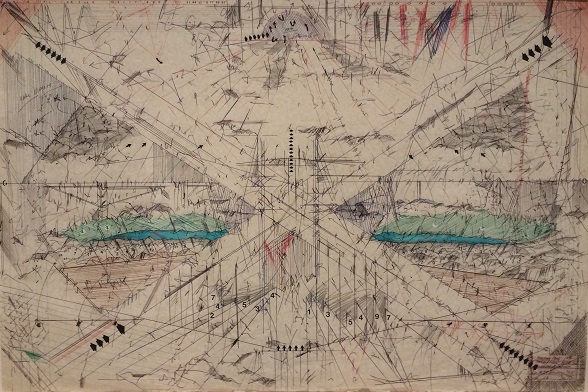
John White
American, 1937-
Golf Course Notations, 1975
Mixed media on paper
23 x 34 in.

John White - undated photo
"I completed a series of large information drawings, showing golf shot trajectories and eye movement patterns. This studio activity brought me much closer to the initial impulses surrounding the entire event. The retracing of the steps also increased the number of new ideas ..." - John White
COMMENTS
Westchester Course, a series of new paintings and drawings by John White, is based on the game of golf. It centers on one hole at one course in Los Angeles and exposes changing moods of a single situation. White knows his subject well; he was close to pro status in the fifties and he is still an avid golfer.
The art world doesn’t take kindly to establishment habits, so White catches a large dose of needling. In the days when such things bothered him, he became a closet jock. Now he plays openly and regularly – often with other artists who share his addiction. If the word gets out, the country club set may have to find another occupation.
When White switched his professional interest from golf to art, he enrolled at Otis Art Institute. A few years later he won a New Talent award at the Los Angeles County Museum of Art. Recently, he has built an impressive record as a performance artist. All three roles – game player, object maker and performer – mingle effectively in his new work.
Golf is White’s apparent subject, but space is a major concern in his performance and painting. As a performer, he uses all available space by cutting across it, walking through it and telling stories from different locations. His paintings “tee off” from a central triangle and explode into an expansive space of abstract landscape, atmosphere and architecture.
White works on 4’ x 8’ sheets of Plexiglas with acrylic pigment, marking pens and Letraset. His nearly symmetrical compositions are halved, quartered and split diagonally from corner to corner. This structure serves as a matrix for soft atmospheric color and furious calligraphy.
Weather conditions, shadows, reflections, noise and physical obstructions are suggested by patches of color (green greens, blue lakes, gray clouds), linear movement and multiple planes. Active black line defines gusty winds, swirling clouds, trajectories of golf balls and edges of planes that jut out of hazy space. Tiny black letters and arrows trace the progress of each game.
In working through his series of six paintings, White passes from relatively specific shapes and high contrast to less distinct edges and close values. The last work is nearly free of linear definition and specific reference. All the paintings can be read as landscape abstractions by those who are not hip to golf, but later works are particularly subtle. They move beyond narrative content to pure abstraction and flatness. White retains solid structure of the earlier work and manages a difficult transition with ease.
Eight colored ink drawings share the paintings’ symmetry and general subject matter, but they are cleaner and more precise. White defines volumes and crisp shapes with energetic, bright line on white grounds.
All things considered, White’s new work is a treat. He transforms a stodgy game into an open-ended attitude that ends with a beautiful painting.
- Suzanne Muchnic,, "John White: Golf Strategies, Art Strategies," Artweek, v 9, n 12, (March 25, 1978), p. 7, illus.
SBMA CURATORIAL LABELS
John White is a painter, sculptor, and performance artist who emerged from the first wave of conceptual art that began in the late 1960s in California. His large performances were often participatory, such as Preparation F (1971), in which a football team is seated in the bleachers while a crowd puts on football uniforms and takes to the field. Since his formal retirement from performance in 1989, he has focused mostly on painting.
White’s early drawings relate to his performances and are often collaged with charts, photographs, and miscellaneous ephemera. An avid golfer, the artist drew from the sport for his Golf Course Notations series, which charts the optimal trajectory for the ball across the course. The sight lines create a cartographic landscape, layered with different perspectives and diagrams. Drawing his imagery from personal experience, White’s work is infused with imagination and a sense of playful irreverence.
- Summer Nocturne, 2018
